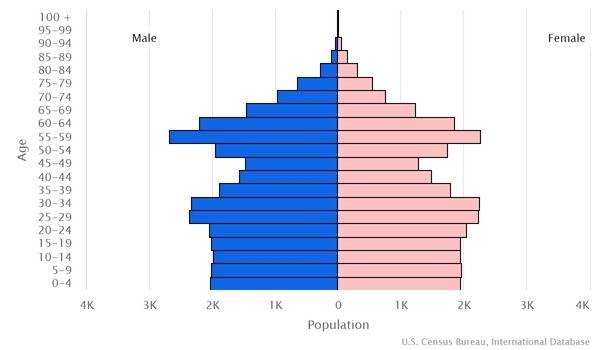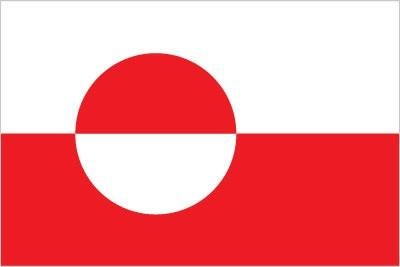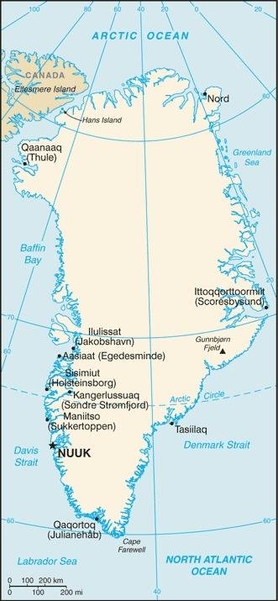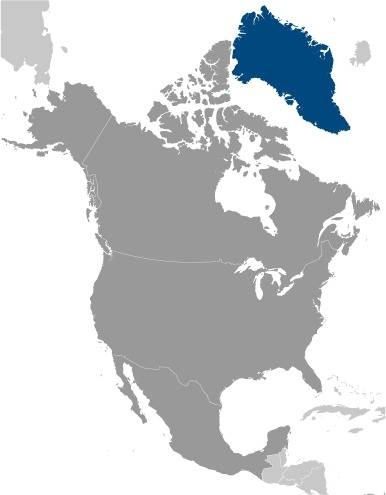Greenland
Introduction
Background
Greenland, the world's largest island, is about 80% ice-capped. Vikings reached the island in the 10th century from Iceland; Danish colonization began in the 18th century, and Greenland became an integral part of the Danish Realm in 1953. It joined the European Community (now the EU) with Denmark in 1973 but withdrew in 1985 over a dispute centered on stringent fishing quotas. Greenland remains a member of the Overseas Countries and Territories Association of the EU. Greenland was granted self-government in 1979 by the Danish parliament; the law went into effect the following year. Greenland voted in favor of increased self-rule in November 2008 and acquired greater responsibility for internal affairs when the Act on Greenland Self-Government was signed into law in June 2009. Denmark, however, continues to exercise control over several policy areas on behalf of Greenland, including foreign affairs, security, and financial policy in consultation with Greenland's Self-Rule Government.
Visit the Definitions and Notes page to view a description of each topic.
Geography
Location
Northern North America, island between the Arctic Ocean and the North Atlantic Ocean, northeast of Canada
Geographic coordinates
72 00 N, 40 00 W
Map references
Arctic Region
Area
total: 2,166,086 sq km
land: 2,166,086 sq km (approximately 1,710,000 sq km ice-covered)
Area - comparative
slightly more than three times the size of Texas
Land boundaries
total: 0 km
Coastline
44,087 km
Maritime claims
territorial sea: 3 nm
continental shelf: 200 nm or agreed boundaries or median line
exclusive fishing zone: 200 nm or agreed boundaries or median line
Climate
arctic to subarctic; cool summers, cold winters
Terrain
flat to gradually sloping icecap covers all but a narrow, mountainous, barren, rocky coast
Elevation
highest point: Gunnbjorn Fjeld 3,694 m
lowest point: Atlantic Ocean 0 m
mean elevation: 1,792 m
Natural resources
coal, iron ore, lead, zinc, molybdenum, diamonds, gold, platinum, niobium, tantalite, uranium, fish, seals, whales, hydropower, possible oil and gas
Land use
agricultural land: 0.6% (2018 est.)
arable land: 0% (2018 est.)
permanent crops: 0% (2018 est.)
permanent pasture: 0.6% (2018 est.)
forest: 0% (2018 est.)
other: 99.4% (2018 est.)
Population distribution
settlement concentrated on the southwest shoreline, with limited settlements scattered along the remaining coast; interior is uninhabited
Natural hazards
continuous permafrost over northern two-thirds of the island
Geography - note
dominates North Atlantic Ocean between North America and Europe; sparse population confined to small settlements along coast; close to one-quarter of the population lives in the capital, Nuuk; world's second largest ice sheet after that of Antarctica covering an area of 1.71 million sq km (660,000 sq mi) or about 79% of the island, and containing 2.85 million cu km (684 thousand cu mi) of ice (this is almost 7% of all of the world's fresh water); if all this ice were converted to liquid water, one estimate is that it would be sufficient to raise the height of the world's oceans by 7.2 m (24 ft)
People and Society
Nationality
noun: Greenlander(s)
adjective: Greenlandic
Ethnic groups
Greenlandic 89.1%, Danish 7.5%, other Nordic peoples 0.9%, and other 2.5% (2022 est.)
note: data represent population by country of birth
Languages
Greenlandic (West Greenlandic or Kalaallisut is the official language), Danish, English
Religions
Evangelical Lutheran, traditional Inuit spiritual beliefs
Age structure
0-14 years: 20.82% (male 6,079/female 5,916)
15-24 years: 14.45% (male 4,186/female 4,137)
25-54 years: 39.72% (male 11,962/female 10,921)
55-64 years: 14.66% (male 4,561/female 3,886)
65 years and over: 10.36% (male 3,170/female 2,798) (2020 est.)

Dependency ratios
total dependency ratio: 43.6
youth dependency ratio: 30
elderly dependency ratio: 13.6
potential support ratio: 7.4 (2021)
Median age
total: 34.3 years
male: 35.1 years
female: 33.4 years (2020 est.)
Population distribution
settlement concentrated on the southwest shoreline, with limited settlements scattered along the remaining coast; interior is uninhabited
Urbanization
urban population: 87.9% of total population (2023)
rate of urbanization: 0.41% annual rate of change (2020-25 est.)
Major urban areas - population
18,000 NUUK (capital) (2018)
Sex ratio
at birth: 1.05 male(s)/female
0-14 years: 1.03 male(s)/female
15-24 years: 1.01 male(s)/female
25-54 years: 1.08 male(s)/female
55-64 years: 1.19 male(s)/female
65 years and over: 0.84 male(s)/female
total population: 1.08 male(s)/female (2022 est.)
Infant mortality rate
total: 8.75 deaths/1,000 live births
male: 10.25 deaths/1,000 live births
female: 7.16 deaths/1,000 live births (2022 est.)
Life expectancy at birth
total population: 73.98 years
male: 71.28 years
female: 76.82 years (2022 est.)
Drinking water source
improved: urban: 100% of population
rural: 100% of population
total: 100% of population
unimproved: urban: 0% of population
rural: 0% of population
total: 0% of population (2020 est.)
Physicians density
1.87 physicians/1,000 population (2016)
Hospital bed density
14 beds/1,000 population (2016)
Sanitation facility access
improved: urban: 100% of population
rural: 100% of population
total: 100% of population
unimproved: urban: 0% of population
rural: 0% of population
total: 0% of population (2020 est.)
Literacy
definition: age 15 and over can read and write
total population: 100%
male: 100%
female: 100% (2015)
Environment
Environment - current issues
especially vulnerable to climate change and disruption of the Arctic environment; preservation of the Inuit traditional way of life, including whaling and seal hunting
Air pollutants
carbon dioxide emissions: 0.51 megatons (2016 est.)
Climate
arctic to subarctic; cool summers, cold winters
Land use
agricultural land: 0.6% (2018 est.)
arable land: 0% (2018 est.)
permanent crops: 0% (2018 est.)
permanent pasture: 0.6% (2018 est.)
forest: 0% (2018 est.)
other: 99.4% (2018 est.)
Urbanization
urban population: 87.9% of total population (2023)
rate of urbanization: 0.41% annual rate of change (2020-25 est.)
Revenue from forest resources
forest revenues: 0% of GDP (2018 est.)
country comparison to the world: 169Waste and recycling
municipal solid waste generated annually: 50,000 tons (2010 est.)
Government
Country name
conventional long form: none
conventional short form: Greenland
local long form: none
local short form: Kalaallit Nunaat
etymology: named by Norwegian adventurer Erik THORVALDSSON (Erik the Red) in A.D. 985 in order to entice settlers to the island
Government type
parliamentary democracy (Parliament of Greenland or Inatsisartut)
Dependency status
part of the Kingdom of Denmark; self-governing overseas administrative division of Denmark since 1979
Capital
name: Nuuk (Godthaab)
geographic coordinates: 64 11 N, 51 45 W
time difference: UTC-3 (2 hours ahead of Washington, DC, during Standard Time)
daylight saving time: +1hr, begins last Sunday in March; ends last Sunday in October
time zone note: Greenland has four time zones
etymology: "nuuk" is the Inuit word for "cape" and refers to the city's position at the end of the Nuup Kangerlua fjord
Administrative divisions
5 municipalities (kommuner, singular kommune); Avannaata, Kujalleq, Qeqertalik, Qeqqata, Sermersooq
note: Northeast Greenland National Park (Kalaallit Nunaanni Nuna Eqqissisimatitaq) and the Thule Air Base in Pituffik (in northwest Greenland) are two unincorporated areas; the national park's 972,000 sq km - about 46% of the island - makes it the largest national park in the world and also the most northerly
Independence
none (extensive self-rule as part of the Kingdom of Denmark; foreign affairs is the responsibility of Denmark, but Greenland actively participates in international agreements relating to Greenland)
National holiday
National Day, June 21; note - marks the summer solstice and the longest day of the year in the Northern Hemisphere
Constitution
history: previous 1953 (Greenland established as a constituency in the Danish constitution), 1979 (Greenland Home Rule Act); latest 21 June 2009 (Greenland Self-Government Act)
Legal system
the laws of Denmark apply where applicable and Greenlandic law applies to other areas
Citizenship
see Denmark
Suffrage
18 years of age; universal
Executive branch
chief of state: Queen MARGRETHE II of Denmark (since 14 January 1972), represented by High Commissioner Mikaela ENGELL (since April 2011)
head of government: Premier Mute B. EGEDE (since 23 April 2021)
cabinet: Self-rule Government (Naalakkersuisut) elected by the Parliament (Inatsisartut)
elections/appointments: the monarchy is hereditary; high commissioner appointed by the monarch; premier indirectly elected by Parliament for a 4-year term
election results: 2021: Mute B. EGEDE elected premier; Parliament vote - Mute B. EGEDE 20-0
2014: Kim KIELSEN elected premier; Parliament vote - Kim KIELSEN (S) 27.2%, Sara OLSVIG (IA) 25.5%, Randi Vestergaard EVALDSEN (D) 19.5%, other 27.8%
Legislative branch
description: unicameral Parliament or Inatsisartut (31 seats; members directly elected in multi-seat constituencies by party-list proportional representation vote - using the d'Hondt method - to serve 4-year terms)
Greenland elects 2 members to the Danish Parliament to serve 4-year terms
elections: Greenland Parliament - last held on 6 April 2021 (next to be held in 2025)
Greenland members to Danish Parliament - last held on 5 June 2019 (next to be held by 4 June 2023)
election results: Greenland Parliament - percent of vote by party - IA 38.7%, S 32.2%, N 12.9%, D 9.7%, A 6.5%; seats by party - IA 12, S 10, N 4, D 3, A 2; composition - men 21, women 10, percent of women 32.2%
Greenland members in Danish Parliament - percent of vote by party - NA; seats by party - IA 1, S 1; composition - 2 women
Judicial branch
highest court(s): High Court of Greenland (consists of the presiding professional judge and 2 lay assessors); note - appeals beyond the High Court of Greenland can be heard by the Supreme Court (in Copenhagen)
judge selection and term of office: judges appointed by the monarch upon the recommendation of the Judicial Appointments Council, a 6-member independent body of judges and lawyers; judges appointed for life with retirement at age 70
subordinate courts: Court of Greenland; 18 district or magistrates' courts
Political parties and leaders
Democrats Party (Demokraatit) or D [Jens Frederik NIELSEN]
Fellowship Party (Atassut) or A [Aqqalu JERIMIASSEN]
Forward Party (Siumut) or S [Erik JENSEN]
Inuit Community (Inuit Ataqatigiit) or IA [Mute Bourup EGEDE]
Signpost Party (Naleraq) or N [Pele BROBERG] (formerly Partii Naleraq)
International organization participation
Arctic Council, ICC, NC, NIB, UPU
Diplomatic representation in the US
chief of mission: Kenneth HOEGH, Head of Representation; note - Greenland also has offices in the Danish consulates in Chicago and New York
chancery: Greenland Representation
3200 Whitehaven Street, NW
Washington, DC 20008
telephone: 202-797-5392
email address and website:
washington@nanoq.gl
https://naalakkersuisut.gl/en/Naalakkersuisut/Groenlands-repraesentation-Washington
Diplomatic representation from the US
chief of mission: Consul Joanie SIMON (since June 2021)
embassy: Aalisartut Aqqutaa 47
Nuuk 3900
Greenland
telephone: (+299) 384100
email address and website:
https://dk.usembassy.gov/embassy-consulate/nuuk/
Flag description
two equal horizontal bands of white (top) and red with a large disk slightly to the hoist side of center - the top half of the disk is red, the bottom half is white; the design represents the sun reflecting off a field of ice; the colors are the same as those of the Danish flag and symbolize Greenland's links to the Kingdom of Denmark
National symbol(s)
polar bear; national colors: red, white
National anthem
name: "Nunarput utoqqarsuanngoravit" (Our Country, Who's Become So Old also translated as You Our Ancient Land)
lyrics/music: Henrik LUND/Jonathan PETERSEN
note: adopted 1916; the government also recognizes "Nuna asiilasooq" as a secondary anthem
National heritage
total World Heritage Sites: 3 (2 cultural, 1 natural); note - excerpted from the Denmark entry
selected World Heritage Site locales: Ilulissat Icefjord (n); Kujataa, Norse and Inuit Farming (c); Aasivissuit–Nipisat, Inuit Hunting Ground (c)
Economy
Economic overview
Greenland’s economy depends on exports of shrimp and fish, and on a substantial subsidy from the Danish Government. Fish account for over 90% of its exports, subjecting the economy to price fluctuations. The subsidy from the Danish Government was budgeted to be about $535 million in 2017, more than 50% of government revenues, and 25% of GDP.
The economy is expanding after a period of decline. The economy contracted between 2012 and 2014, grew by 1.7% in 2015 and by 7.7%in 2016. The expansion has been driven by larger quotas for shrimp, the predominant Greenlandic export, and also by increased activity in the construction sector, especially in Nuuk, the capital. Private consumption and tourism also are contributing to GDP growth more than in previous years. Tourism in Greenland grew annually around 20% in 2015 and 2016, largely a result of increasing numbers of cruise lines now operating in Greenland's western and southern waters during the peak summer tourism season.
The public sector, including publicly owned enterprises and the municipalities, plays a dominant role in Greenland's economy. During the last decade the Greenland Self Rule Government pursued conservative fiscal and monetary policies, but public pressure has increased for better schools, health care, and retirement systems. The budget was in deficit in 2014 and 2016, but public debt remains low at about 5% of GDP. The government planned a balanced budget for the 2017–20 period.
Significant challenges face the island, including low levels of qualified labor, geographic dispersion, lack of industry diversification, the long-term sustainability of the public budget, and a declining population due to emigration. Hydrocarbon exploration has ceased with declining oil prices. The island has potential for natural resource exploitation with rare-earth, uranium, and iron ore mineral projects proposed, but a lack of infrastructure hinders development.
Real GDP (purchasing power parity)
$2.413 billion (2015 est.)
$2.24 billion (2014 est.)
$2.203 billion (2013 est.)
note: data are in 2015 US dollars
Real GDP growth rate
7.7% (2016 est.)
1.7% (2015 est.)
-0.8% (2014 est.)
Real GDP per capita
$41,800 (2015 est.)
$38,800 (2014 est.)
$38,500 (2013 est.)
GDP (official exchange rate)
$2.221 billion (2015 est.)
Inflation rate (consumer prices)
0.3% (January 2017 est.)
1.2% (January 2016 est.)
GDP - composition, by sector of origin
agriculture: 15.9% (2015 est.)
industry: 10.1% (2015 est.)
services: 73.9% (2015)
GDP - composition, by end use
household consumption: 68.1% (2015 est.)
government consumption: 28% (2015 est.)
investment in fixed capital: 14.3% (2015 est.)
investment in inventories: -13.9% (2015 est.)
exports of goods and services: 18.2% (2015 est.)
imports of goods and services: -28.6% (2015 est.)
Agricultural products
sheep, cattle, reindeer, fish, shellfish
Industries
fish processing (mainly shrimp and Greenland halibut), anorthosite and ruby mining, handicrafts, hides and skins, small shipyards
Labor force - by occupation
agriculture: 15.9%
industry: 10.1%
services: 73.9% (2015 est.)
Population below poverty line
16.2% (2015 est.)
Gini Index coefficient - distribution of family income
33.9 (2015 est.)
34.3 (2014 est.)
Household income or consumption by percentage share
lowest 10%: NA
highest 10%: NA
Budget
revenues: 1.719 billion (2016 est.)
expenditures: 1.594 billion (2016 est.)
Fiscal year
calendar year
Exports - partners
Denmark 55%, China 22%, Japan 6% (2019)
Exports - commodities
fish, crustaceans, fishing ships (2019)
Imports - partners
Denmark 51%, Spain 23%, Sweden 12%, Iceland 7% (2019)
Imports - commodities
fishing ships, refined petroleum, construction vehicles, crustaceans, delivery trucks (2019)
Exchange rates
Danish kroner (DKK) per US dollar -
6.586 (2017 est.)
6.7309 (2016 est.)
6.7309 (2015 est.)
6.7326 (2014 est.)
5.6125 (2013 est.)
Energy
Electricity access
electrification - total population: 100% (2020)
Electricity
installed generating capacity: 187,000 kW (2020 est.)
consumption: 481.7 million kWh (2019 est.)
exports: 0 kWh (2020 est.)
imports: 0 kWh (2020 est.)
transmission/distribution losses: 17 million kWh (2019 est.)
Electricity generation sources
fossil fuels: 15.8% of total installed capacity (2020 est.)
nuclear: 0% of total installed capacity (2020 est.)
solar: 0% of total installed capacity (2020 est.)
wind: 0% of total installed capacity (2020 est.)
hydroelectricity: 84.2% of total installed capacity (2020 est.)
tide and wave: 0% of total installed capacity (2020 est.)
geothermal: 0% of total installed capacity (2020 est.)
biomass and waste: 0% of total installed capacity (2020 est.)
Coal
production: 0 metric tons (2020 est.)
consumption: 0 metric tons (2020 est.)
exports: 0 metric tons (2020 est.)
imports: 0 metric tons (2020 est.)
proven reserves: 183 million metric tons (2019 est.)
Petroleum
total petroleum production: 0 bbl/day (2021 est.)
refined petroleum consumption: 4,000 bbl/day (2019 est.)
crude oil and lease condensate exports: 0 bbl/day (2018 est.)
crude oil and lease condensate imports: 0 bbl/day (2018 est.)
crude oil estimated reserves: 0 barrels (2021 est.)
Natural gas
production: 0 cubic meters (2021 est.)
consumption: 0 cubic meters (2021 est.)
exports: 0 cubic meters (2021 est.)
imports: 0 cubic meters (2021 est.)
proven reserves: 0 cubic meters (2021 est.)
Carbon dioxide emissions
605,000 metric tonnes of CO2 (2019 est.)
from coal and metallurgical coke: 0 metric tonnes of CO2 (2019 est.)
from petroleum and other liquids: 605,000 metric tonnes of CO2 (2019 est.)
from consumed natural gas: 0 metric tonnes of CO2 (2019 est.)
Communications
Telephones - fixed lines
total subscriptions: 6,352 (2020 est.)
subscriptions per 100 inhabitants: 11 (2020 est.)
Telephones - mobile cellular
total subscriptions: 65,958 (2020 est.)
subscriptions per 100 inhabitants: 116 (2020 est.)
Telecommunication systems
general assessment: adequate domestic and international service provided by satellite, cables, and microwave radio relay; the fundamental telecommunications infrastructure consists of a digital radio link from Nanortalik in south Greenland to Uummannaq in north Greenland; satellites cover north and east Greenland for domestic and foreign telecommunications; a marine cable connects south and west Greenland to the rest of the world, extending from Nuuk and Qaqortoq to Canada and Iceland; a contract has been awarded to build a 5G network in Greenland, initially covering three towns, with 10 towns, including Greenland's capital Nuuk to follow (2022)
domestic: nearly 11 per 100 for fixed-line subscriptions and 116 per 100 for mobile-cellular (2020)
international: country code - 299; landing points for Greenland Connect, Greenland Connect North, Nunavut Undersea Fiber System submarine cables to Greenland, Iceland, and Canada; satellite earth stations - 15 (12 Intelsat, 1 Eutelsat, 2 Americom GE-2 (all Atlantic Ocean)) (2019)
note: the COVID-19 pandemic continues to have a significant impact on production and supply chains globally; since 2020, some aspects of the telecom sector have experienced a downturn, particularly in mobile device production; progress toward 5G implementation has resumed, as well as upgrades to infrastructure; consumer spending on telecom services has increased due to the surge in demand for capacity and bandwidth; the crucial nature of telecom services as a tool for work and school from home is still evident, and the spike in this area has seen growth opportunities for development of new tools and increased services
Broadcast media
the Greenland Broadcasting Company provides public radio and TV services throughout the island with a broadcast station and a series of repeaters; a few private local TV and radio stations; Danish public radio rebroadcasts are available (2019)
Internet users
total: 39,358 (2019 est.)
percent of population: 70% (2019 est.)
Broadband - fixed subscriptions
total: 15,649 (2020 est.)
subscriptions per 100 inhabitants: 28 (2020 est.)
Transportation
National air transport system
number of registered air carriers: 1 (2020) (registered in Denmark)
inventory of registered aircraft operated by air carriers: 8 (registered in Denmark)
Airports - with paved runways
total: 10
2,438 to 3,047 m: 2
1,524 to 2,437 m: 1
914 to 1,523 m: 1
under 914 m: 6 (2021)
Airports - with unpaved runways
total: 5
1,524 to 2,437 m: 1
914 to 1,523 m: 2
under 914 m: 2 (2021)
Roadways
note: although there are short roads in towns, there are no roads between towns; inter-urban transport is either by sea or by air
Ports and terminals
major seaport(s): Sisimiut
Military and Security
Military and security forces
no regular military forces or conscription
Military - note
the Danish military’s Joint Arctic Command in Nuuk is responsible for the defense of Greenland
Transnational Issues
Disputes - international
managed dispute between Canada and Denmark over Hans Island in the Kennedy Channel between Canada's Ellesmere Island and Greenland; Denmark (Greenland) and Norway have made submissions to the Commission on the Limits of the Continental Shelf (CLCS) and Russia is collecting additional data to augment its 2001 CLCS submission



